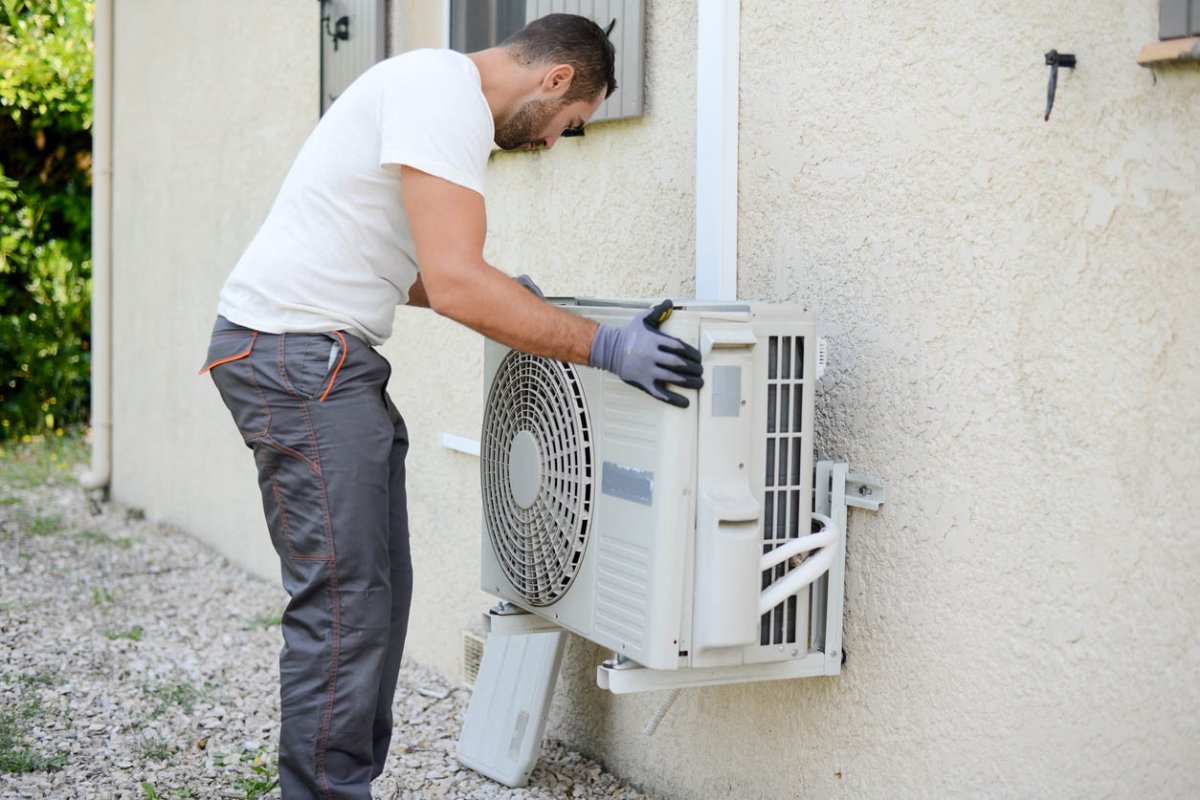We may earn revenue from the products available on this page and participate in affiliate programs. Learn More ›
Highlights
- A mini-split air conditioner typically costs between $2,000 and $14,500 to install, with a national average cost of $3,000.
- The main factors that affect mini-split installation cost include the unit size, type, efficiency, and brand; the number of zones; the installation location; and the cost of labor.
- A ductless mini-split system has many benefits, including efficiency and sustainability, a low cost and low noise level, the ability to adjust the temperature in specific zones, and a potentially increased home value.
- Homeowners are encouraged to hire a professional for their project; a professional knows how to install a mini-split to ensure it functions properly and doesn’t leak.
In many homes, it’s a struggle to keep everyone happy with the interior temperature, but there are ways around the problem. The best solution is a mini-split system installation, which provides individualized control over the temperature in each room where the unit is installed. This solution is also more efficient and cost-effective than installing an entire HVAC system with ductwork.
According to Angi and HomeAdvisor, mini-split installation cost ranges between $2,000 and $14,500, with an average of $3,000. The size of the house and the number of rooms primarily drive the cost. This guide will cover everything homeowners need to know about mini-split system costs, including the main factors that affect the project cost, the types of mini-split systems available, the benefits of this type of system, and tips on hiring a pro for this project.
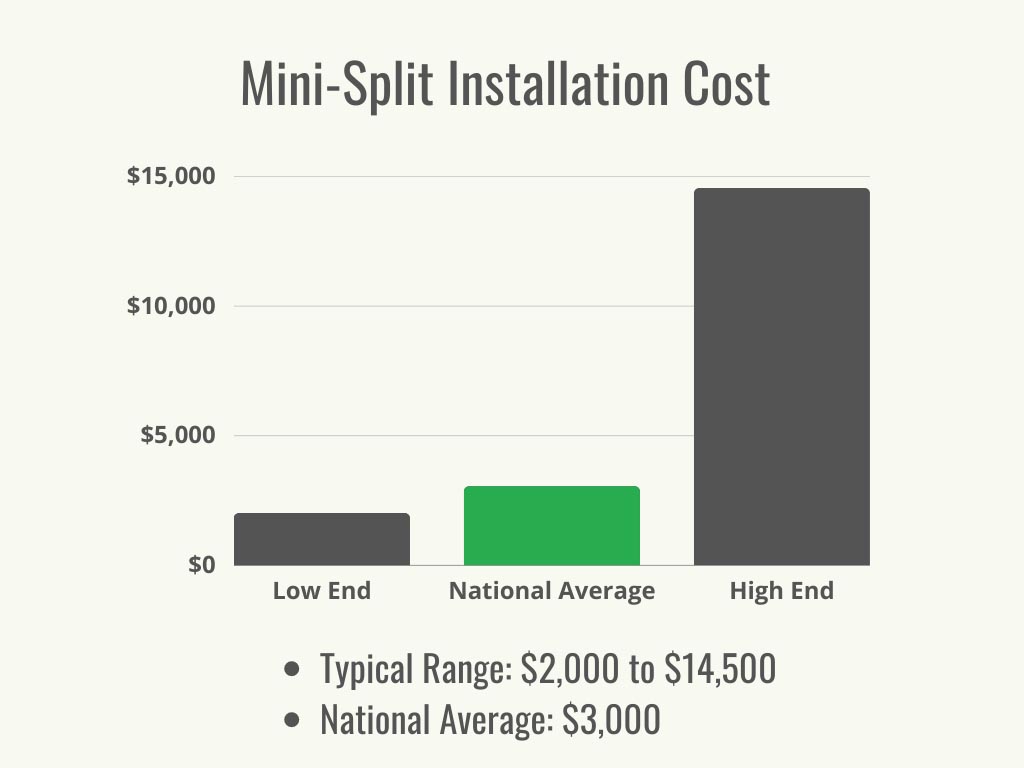
What Is a Ductless Mini-Split Air Conditioner?
Mini-split systems heat and cool a house without the ductwork needed for a traditional HVAC system. They still use an outdoor compressor and condenser, but they feed each indoor air-handling unit with a simple conduit that operates like a heat pump.
The indoor evaporating unit is installed in each room where homeowners want individualized temperature control. It’s typically mounted to a wall or ceiling and doesn’t take up a lot of space. Any room with this air-handling unit will have its own thermostat to control heating and cooling.
These units can be installed in homes with existing ductwork when only one or two rooms need additional heating or cooling. They also work well in homes where it’s challenging to install ductwork in the attic.
Factors in Calculating Mini-Split Installation Cost
A mini-split AC installation cost runs about 50 percent less than central AC unit cost, partly due to the lack of ductwork and extra labor needed. Still, there are several components required to install a ductless system properly. Mini-split air conditioner installation costs are also driven by the unit size, labor, location in the house, number of zones, brand, and efficiency rating. The following section explains how each of these factors affects the cost to install a mini-split system.
Unit Size
Mini-split AC prices are heavily affected by the size of the unit chosen. The most common size is a 12,000 BTU-capacity unit, and those usually cost between $700 and $3,200. Mini-split systems usually have at least one room connected, but they could power up to five indoor units.
If more rooms each need their own air-handling unit, then additional units can be purchased (typically $450 to $1,600 each), or a larger condenser can be installed. Homeowners will want to speak to an HVAC company to compare the installation costs and the operating costs for their area if they need more than five units in different rooms, as this is the maximum most brands can accommodate.
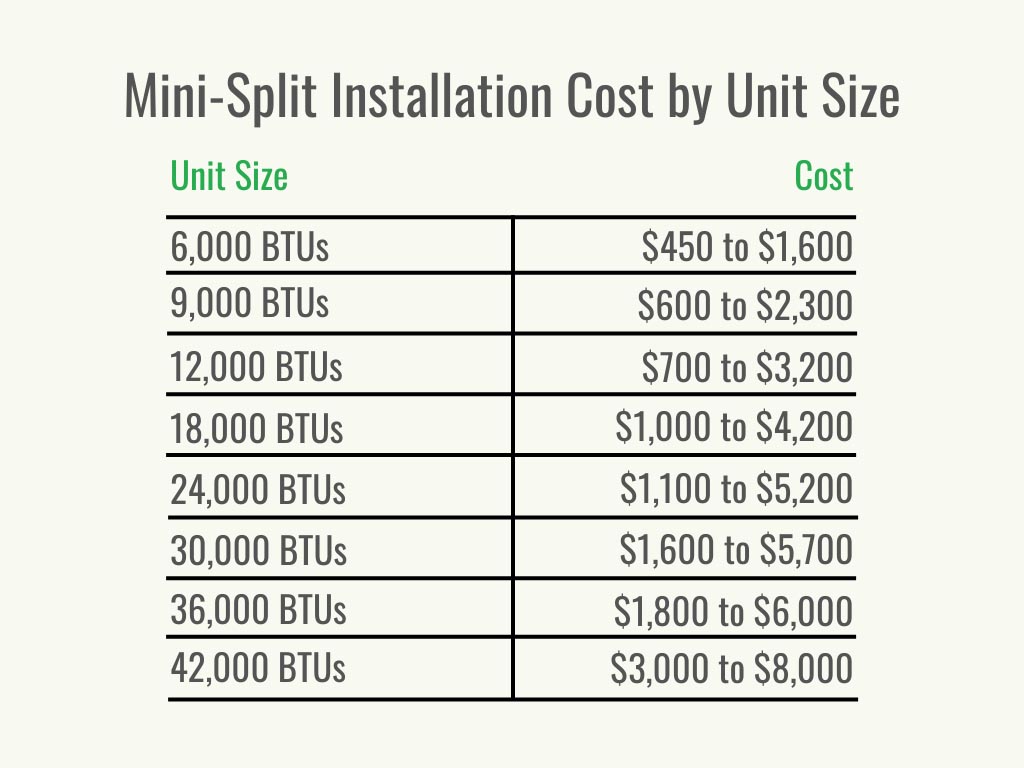
Unit Type
Mini-split systems have a fairly limited number of components compared to some mechanical systems. In addition to deciding if they want a single-zone or a multi-zone system, homeowners will want to choose whether they want the in-room units mounted on the ceiling, wall, or floor.
Wall-mounted units are the most common due to their lower cost; however, many homeowners find them unsightly. A floor-mounted unit is actually installed on a wall, but close to the floor. If a homeowner prefers a ceiling mount, they can choose a protruding option for a higher ceiling or a recessed ceiling cassette for a lower ceiling. Each type of system and its average cost is described in detail in a section below.
Unit Efficiency
A unit’s efficiency will also have an effect on the total cost. When an HVAC unit has a higher seasonal energy efficiency ratio (SEER) rating, it will cost less to run since it operates more efficiently. It’s one factor for a homeowner to consider as they select the mini-split unit that’s best for their home and region. Areas with more extreme temperatures might benefit from a higher SEER-rated system since it will probably run more often.
Energy-efficient units often come with rebates from utility companies and tax credits from local and state governments. However, mini-split AC units with a higher SEER rating can often cost more up front even if a homeowner will save more in the long run, so it’s advisable for a homeowner to consider what’s best for their budget and overall needs.
Unit Brand
As with most mechanical units, there are a variety of brands to choose from when it comes to ductless mini-split units. Many are well-known brands and typically have a higher price point, and others are lesser-known brands with lower price points.
| Unit Brand | Average Cost |
| Daikin | $1,000 to $4,000 |
| Fujitsu | $1,100 to $8,300 |
| Mitsubishi | $1,200 to $8,650 |
| Panasonic | $1,700 to $2,800 |
| Rheem | $1,100 to $8,300 |
Homeowners can also ask about numerous other brands, including Samsung, Cooper & Hunter, LG, and more. Many of these brands are available at major home improvement stores, so homeowners may want to research Lowe’s or Home Depot mini-split installation cost to see if it’s comparable with a local HVAC installation company.
Number of Zones
Homeowners can purchase mini-splits with a single zone or multi-zones to handle up to five different rooms. (Some brands can handle more.) An HVAC pro will need to assess the square footage of each room to ensure that the homeowner purchases the right unit and number of zones to do the job adequately. Larger rooms like a family room could require two units, which means a quad-zone would be installed in only three rooms. This will increase mini-split prices for the homeowner since more zones mean a larger unit with more components. A single zone averages $2,000 to $8,800; a three-zone unit averages $3,400 to $13,400; and a five-zone unit averages $4,800 to $18,000.
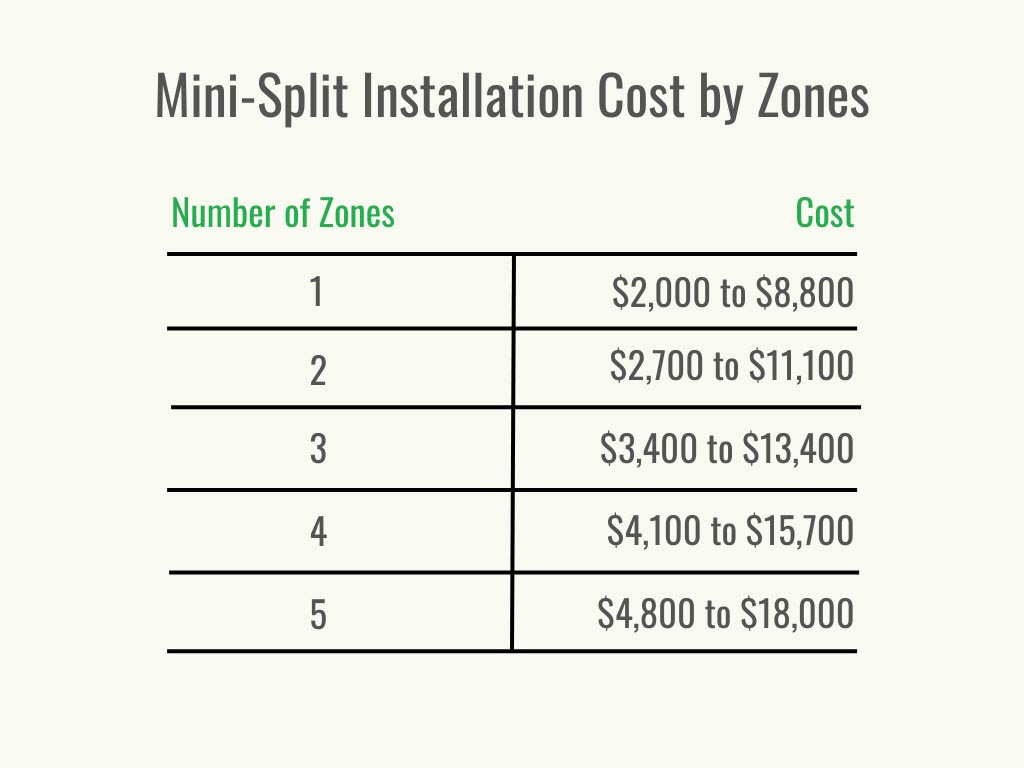
Installation Location
Mini-splits can be installed as zones to cover one or more areas within a home. A quad-zone can usually cover four rooms, depending on their sizes. If an installer needs to add additional zones or units on upper floors, it will cost more for the extra components and labor. A homeowner will probably pay about $10 to $20 per foot for materials, and the work will take a couple of hours.
Sometimes homeowners use this system to heat or cool just their outside patio. If the condenser can be installed nearby, the total cost could end up being cheaper since the air-handling unit won’t be positioned several rooms away.
Labor
Labor makes up only part of mini-split system installation costs, unlike other projects where labor makes up the majority of the cost. For most mini-split AC installations, it will cost $300 to $1,500 to hire an HVAC technician. The best HVAC companies will have most mini-splits installed within 5 to 10 hours.
Refrigerant Lines
When installing a ductless mini-split air conditioner system, homeowners will want to make sure that they budget around $7 per foot for refrigerant lines, which connect the indoor and outdoor units. A home with multiple zones will need more refrigerant lines than one with just one or two zones.
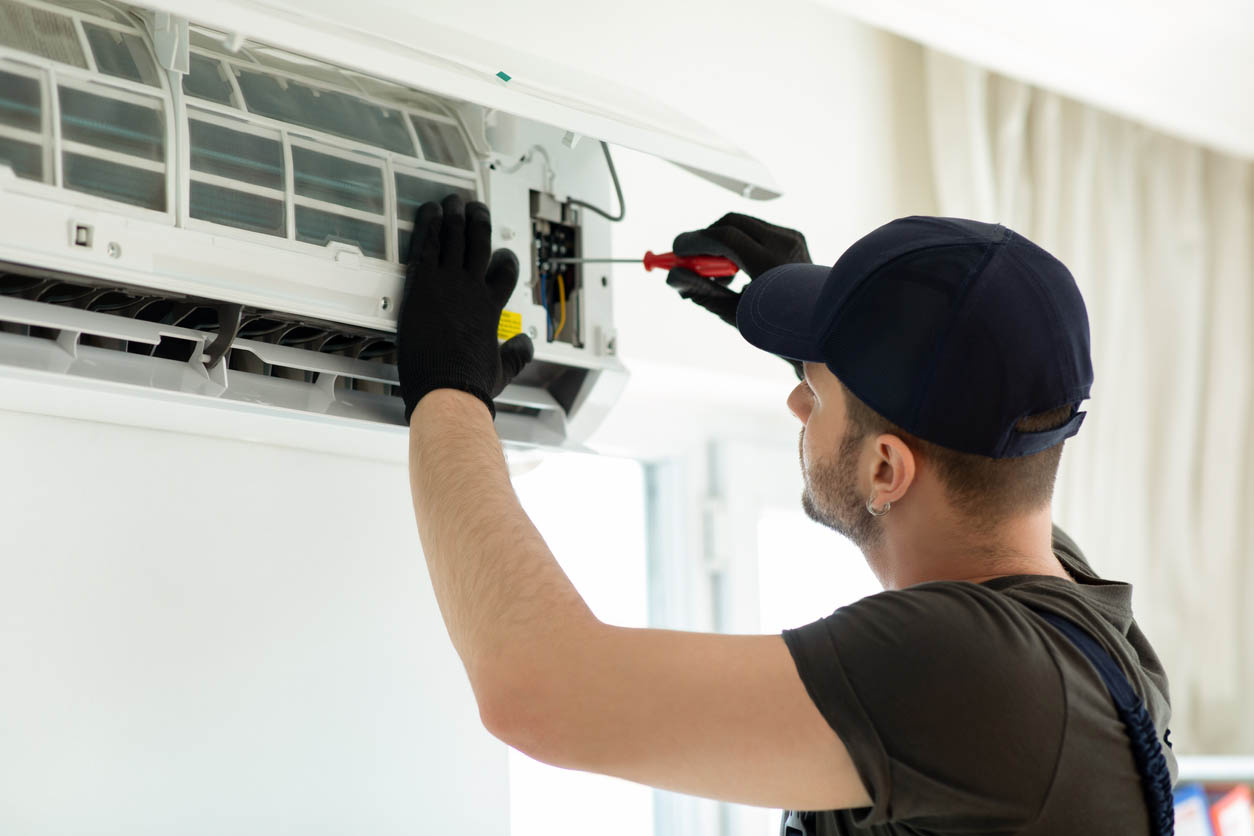
Additional Costs and Considerations
While most homeowners can calculate the total mini-split cost with the previous factors, there are extenuating circumstances where additional costs could be necessary. Some projects will require assistance from other contractors beyond the HVAC technicians. Other projects might need to have an old HVAC unit removed entirely.
Ductless Mini-Split vs. Central AC Installation
Homeowners may wonder what types of AC systems will work best for their home: a ductless mini-split system or central AC. Mini-split AC installation costs less, with an average cost of $3,000 compared with the average cost to install a central AC unit of $5,860. A ductless mini-split system is ideal for single-room cooling or for older homes without existing ductwork, and it can be 20 percent to 60 percent more efficient than a central AC system. However, central air might be a better option for a home with existing ductwork or larger homes that require more even cooling throughout the house.
Permits
A homeowner will likely need to obtain a permit to install a ductless AC system, particularly if it’s a multi-zone mini-split system. It’s recommended for a homeowner to check with their municipality before starting this project. On average, permits can cost between $250 and $400.
Electrical Work
If a home doesn’t have a dedicated 110- or 200-volt box, the homeowner will likely need to hire an electrician to install one. An electrician usually charges between $50 and $100 per hour to make sure the correct circuits are installed to meet local codes. If the home needs a dedicated electrical circuit to be installed, a homeowner can expect to add an extra $250 to their budget.
Carpentry Work
Mini-split system installation may also require the help of a carpenter to cut holes through a home’s exterior—especially if the siding is made from a tough material such as stucco, fiber cement, or wood. Homeowners can expect to pay between $35 to $100 per hour, or around $140 to $600 total, for their expertise.
Old HVAC Removal
Some homeowners could install a ductless AC unit and replace their old central air unit. In this case, it’s best for them to simply remove the old equipment to prevent any issues with old equipment degrading from disuse. Old condensers, ductwork, and even thermostats could be removed in this process. It’s much cheaper to remove old equipment rather than install it, so homeowners can expect to add $80 to $150 for removal to their mini-split AC cost calculations..
Accessories and Upgrades
There are several ways to upgrade a mini-split system. For example, a homeowner might want to install a wireless remote controller to adjust their home’s temperature on the fly, and a home located in a region that gets a lot of snow might need condenser stands to lift the unit up off the ground. The following table shows some of the most common accessories and upgrades along with their average costs.
| Upgrade Type | Average Cost |
| Condensate removal pump | $120 to $280 |
| Condenser stand | $100 to $210 |
| Drain pan heater | $140 to $560 |
| Wall mount bracket | $40 to $100 |
| Wireless remote controller | $50 to $300 |
- Condensate removal pump: Drains excess condensation to improve humidity levels.
- Condenser stand: Lifts the condenser off the ground by several inches.
- Drain pan heater: Prevents the system from freezing during colder weather.
- Wall mount bracket: Allows the homeowner to mount the outdoor unit on the wall.
- Wireless remote controller: Allows the homeowner to control the temperature from anywhere.
Tax Credits and Rebates
If a homeowner installs an energy-efficient mini-split system, they may be eligible for a federal or state tax credit, or even a rebate from the unit manufacturer. Homeowners can ask their HVAC technician whether the unit they choose will be eligible for any rebates or credits.
Warranties
Most mini-split manufacturers will provide a warranty on the unit—though in many cases, the brand will require the system to be installed by a professional in order for the warranty to be valid. Additionally, homeowners may want to consider one of the best home warranties for HVAC like American Home Shield or Liberty Home Guard. A home warranty can help pay to repair or replace home systems and major appliances that fail as a result of normal wear and tear, and home warranties usually cover HVAC repairs, including ductless mini-split units. This can help the homeowner save on HVAC unit replacement costs when their existing unit reaches the end of its life.
Mini-Split Installation Cost by Unit Type
Homeowners will need to determine how many rooms need to have in-room units installed to manage the temperature better. Since the size of the unit is the primary cost factor, the number of zones the unit will connect with is important to know ahead of time. Some homes have just one room that can’t seem to maintain a comfortable temperature, while others have an entire basement or different rooms throughout the house that need extra help. It’s essential for a homeowner to determine whether they need a unit for a single zone or multiple zones before beginning their installation project.
| Unit Type | Average Cost |
| Single-zone | $2,000 to $8,800 |
| Multi-zone | $2,700 to $18,000 |
| Wall-mounted | $400 to $1,000 |
| Floor-mounted | $1,300 to $4,000 |
| Ceiling-mounted | $700 to $2,000 |
| Ceiling cassette | $500 to $2,000 |
Single-Zone
A single-zone mini-split system works well for homes with an open floor plan and little need for controlling individual room temperatures. The condenser will connect to a single indoor air-handling unit that’s placed in an open common area or in the one room that needs heating or cooling. Only one thermostat is installed to control the unit. This mini-split type works well for small homes with average weather, attics, south-facing rooms, or even patios. It’s also possible to install this in addition to an existing central HVAC system. That makes it a convenient and affordable option for homeowners who need a solution for just one room without upgrading an entire HVAC system. On average, a single-zone mini-split system costs between $2,000 and $8,800 to install.
Multi-Zone
Multi-zone mini-split systems are gaining popularity since they usually cost less than traditional HVAC systems. This type of system includes a more powerful condenser unit based on the number of rooms that need their own air-handling unit. Multi-zone systems usually work for two to five rooms. A limited number of brands can even accommodate up to eight rooms. The alternative is to purchase two units, and sometimes that might be the cheaper option than whole-home central air. Homeowners who need multi-zone mini-splits find they’re a cost-effective solution for handling multiple rooms that need their own thermostats. Depending on the number of zones, a multiroom mini-split system can cost between $2,700 and $18,000, including installation.
Wall-Mounted
Installing a mini-split unit on an interior wall is typically the most affordable option—but it’s also the most noticeable option as there’s no way to hide the unit from sight. Wall-mounted units are usually installed just below the ceiling with tubes connecting it to the outdoor unit. They can be used with both single- and multi-zone systems. It typically costs between $400 and $1,000 per head for a wall-mounted mini-split unit.
Floor-Mounted
Although the name suggests it’s mounted directly on the floor, a floor-mounted mini-split unit is actually mounted on the wall, but closer to the floor than a traditional wall-mounted unit. This type of mount is ideal for a multi-zone system or as a supplement to the home’s main heating and cooling system. A floor-mounted mini-split unit typically costs between $1,300 and $4,000.
Ceiling-Mounted
If a homeowner wants their mini-split unit out of sight, a ceiling-mounted unit might be their best option. This type of mount is ideal for a room with a high ceiling; it typically protrudes 14 to 16 inches from the ceiling for effective cooling. Mounting a mini-split unit on a ceiling costs between $700 and $2,000.
Ceiling Cassette
A ceiling cassette is another good option for a homeowner who wants their mini-split unit out of sight. This type of installation is recessed with the grill flush to the ceiling. It has controllable vents that can direct air in up to four different directions. A ceiling cassette unit usually costs between $500 and $2,000.
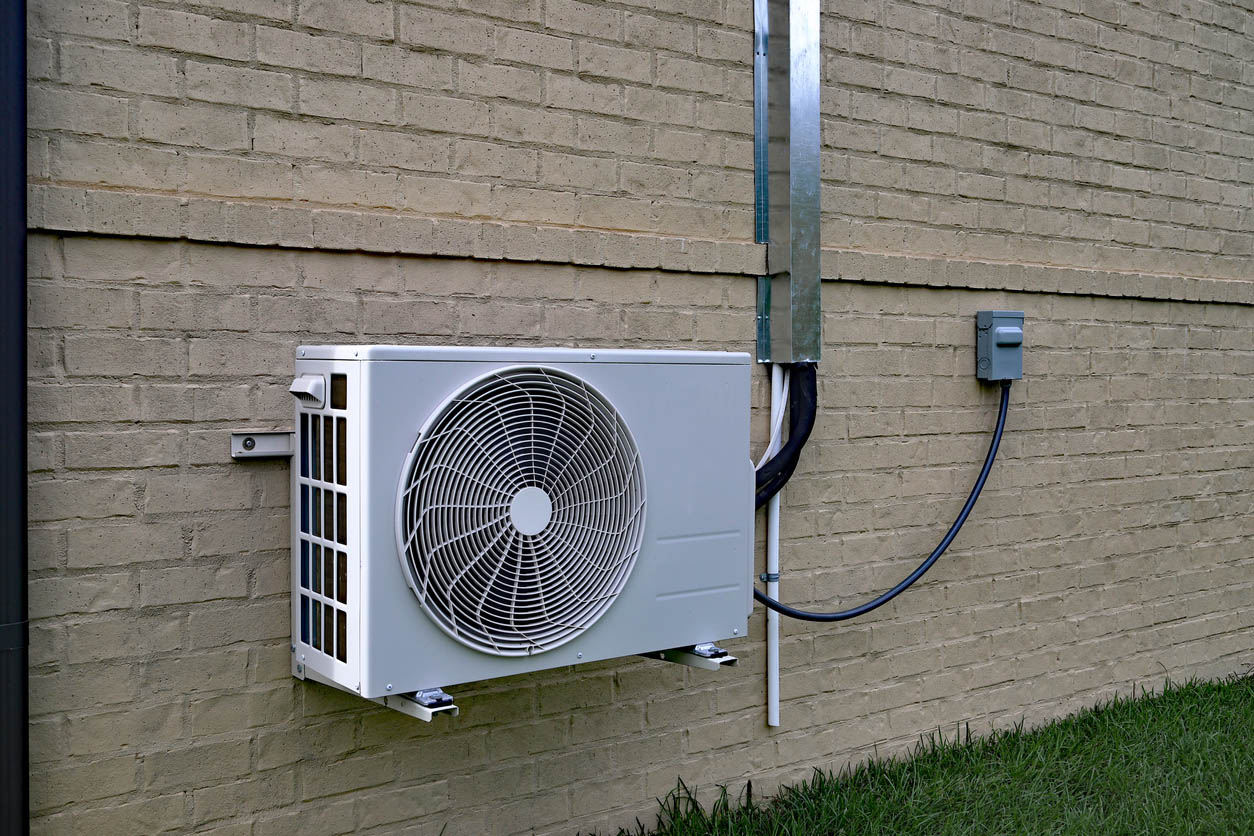
Benefits of Choosing a Ductless Mini-Split
Mini-split or ductless air systems have been gaining in popularity in recent years for several reasons. They’re often more efficient than a central air unit, cost less, run more quietly, and offer much more individualized control. All of those are great benefits that are explained in more detail below.
Efficiency and Sustainability
Mini-split systems use conduits and wiring to run between the two units that power and produce temperature-controlled air. This means two things: less space is required to install the units and fewer materials are needed. Without those bulky ducts, homeowners don’t have to worry about air leaking along the joints or corners, which is often the cause of some inefficient central systems. Overall, ductless systems can run between 20 percent and 60 percent more efficiently than traditional HVAC units.
With fewer components required to install a mini-split AC unit, there’s less impact on the environment overall from creation to replacement. These units also don’t require any other major construction projects for installation, unlike some homes that need modification to make room for ducts. That means there’s no construction waste, either.
Affordability
Mini-splits have fewer components, so the cost of materials is lower than a central air system. And without all those extra materials, a homeowner might also have lower labor costs for installation. Granted, it still takes time to get the units up and running, but it’s usually faster than a full HVAC system. Overall, mini-split systems cost up to 50 percent less than central air conditioning units.
Low Noise
Many central air systems are fairly loud when they run, often between 50 and 80 decibels; this equates to a quiet conversation on the low end to a busy street on the high end. Some of this is due to the large volume of air being sucked into the unit for cooling, and some of it is just the nature of mechanical units. Newer systems tend to run more quietly, but ductless systems run the quietest of all systems (32 decibels is common). Even when comparing ductless mini-splits versus window air conditioners, the latter typically causes a louder racket.
Room-Specific Temperature Adjustment
It’s not uncommon for families to have one or two members who prefer a different temperature. Or sometimes, some rooms get blasted by the afternoon sun or chilled in the dark basement. No matter the cause, a solution to maintaining acceptable temperatures for everyone is installing a multi-zone mini-split. This system puts a thermostat in each room so it can be controlled individually as needed. If the mini-split is the only heating and cooling system in the house, controlling rooms independently can also reduce energy costs since the system only works hard in select areas that require it.
Increased Home Value
Any mechanical system that improves the quality of life increases home value. It’s almost a necessity to have some sort of temperature control in the house that works for that specific region. Another benefit of mini-split systems is that they can be installed in older homes that simply can’t accommodate the infrastructure needed for central air. And if a single zone is added to an existing system to help cool off that one room that always sizzles in the summer, prospective home buyers will be all the more appreciative.
Mini-Split Installation: DIY vs. Hiring a Professional
Mini-split systems are available for purchase from online retailers, but not all of them are efficient or strong enough to get the job done for larger homes. Most homeowners do not calculate their home’s size properly to choose the right unit for their needs. This can lead to higher energy costs and eventual replacement costs for more powerful units down the road. In addition, installing the condenser unit needs to be done carefully. These units have to sit on a level surface to operate properly—plus many states require certified HVAC technicians to handle the refrigerant coolant.
In the long run, a homeowner’s best bet is to have a pro come over and give them an estimate on how many units the home needs and how many BTUs those units should produce to cool the house properly. These pros also know how to choose a mini-split system, as well as exactly which components are necessary and how to install mini-splits with any special tools that might be necessary. Additionally, if the correct electrical outlets aren’t available, a homeowner will need to hire an electrician to install them anyway.
Since labor isn’t a major part of the overall ductless mini-split installation cost, it’s almost not worth it for homeowners to try to save a little by doing it on their own. The last thing a homeowner wants is to improperly install the conduits and end up with a leaky unit. HVAC technicians are well trained to avoid such a problem, and they’ll be able to quickly solve any issues that might arise during installation.
They’ll also have a good pulse on the best brands that would most closely match a homeowner’s needs. Sometimes it can be hard to choose the right brand or unit based on reviews alone, but technicians are familiar with the units that wear out fastest or operate the most quietly. Their expertise can save homeowners money and ensure a boosted home value in the long run.
How to Save Money
Even though a mini-split is often cheaper than a central air system, it’s still a chunk of change to hand over all at once. There’s no reason you can’t find ways to save a little money on the cost of mini-split installation. Here are a few ideas to do just that.
- Stick to fewer zones. Consider how many rooms actually need temperature control and install units only in those rooms.
- Consider single- vs. multi-zone. Have a pro assess whether a cheaper single-zone mini-split can provide the air control you’re looking for in your home.
- Consider your needs. Decide whether you need just heating or just cooling or both to make sure you only pay for the kind of unit you need.
- Consider upgrades. Ask about units with built-in sensors that will automatically shut off at the desired temperature to avoid excessive energy costs.
- Weigh up-front costs vs. long-term costs. Decide whether you want to save on long-term energy costs or up-front installation costs. The higher the SEER rating, the higher the up-front cost, but the system runs more efficiently.
- Shop around. Obtain quotes from more than one company to find the best one for your project and your budget. Consider using a mini-split cost calculator to get an idea of what you might pay.
- Install in the off-season. Consider getting a mini-split installed off-season when demand and prices might be lower.
- Look for discounts. Ask about any discounts for seniors, military, and first responders, and check for online coupons or mailer advertisements.
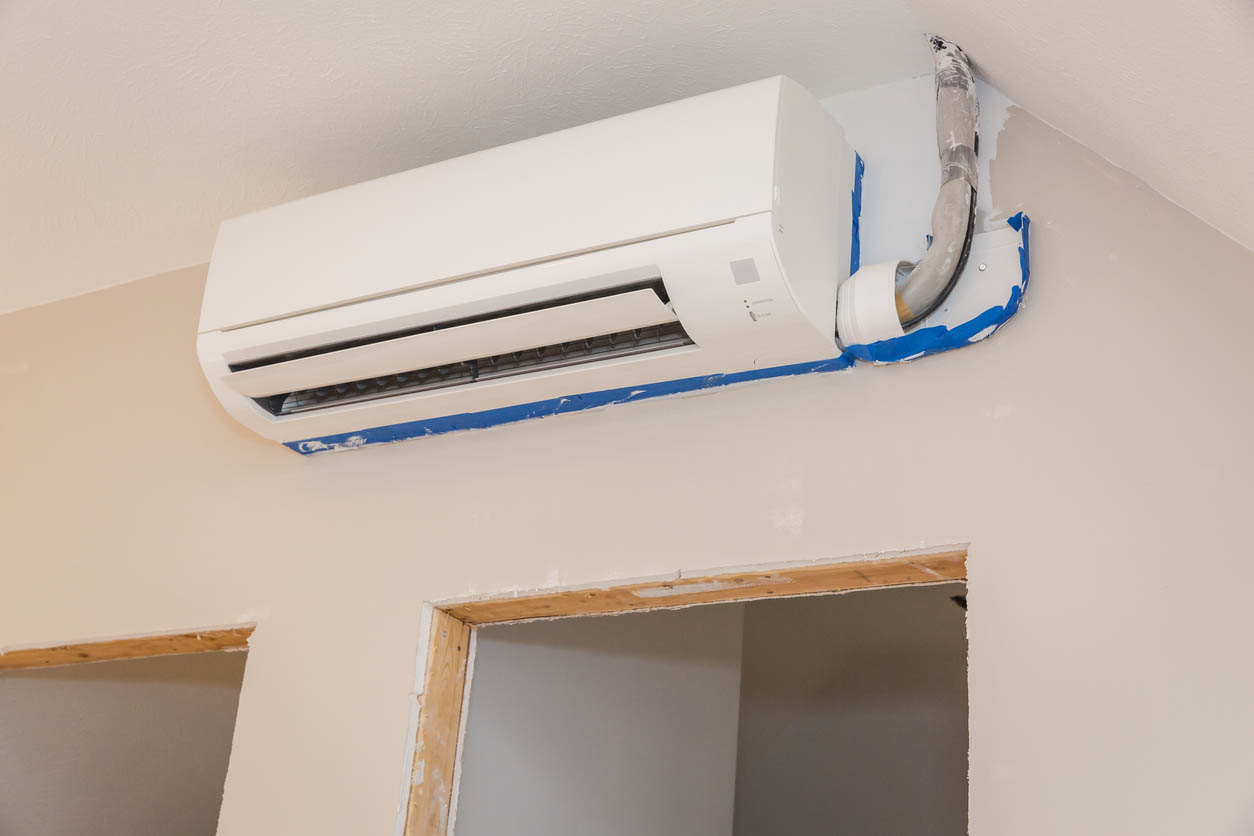
Questions to Ask a Pro
Thinking about adding a new mechanical system to a house can feel confusing at times for homeowners. Prepared with the right questions to ask an HVAC company, a homeowner can avoid confusion, minimize miscommunication, and feel confident about their decision. As always, homeowners will want to first make sure the company is licensed and insured with an established business reputation. Beyond that, they can consider the following questions.
- How long have you worked on mini-split installations?
- How common are mini-splits in my region?
- Do you offer a free consultation to assess the size and type of unit I need?
- Will my home need more than five units? If so, is it better to install a larger unit or two smaller units?
- Can I review a line-item invoice?
- What are the payment terms?
- What if we end up needing an electrician? Do you have someone on staff?
- Will we need a permit?
- What brand of mini-split should I purchase if I’m concerned about my budget? What about if I’m concerned about efficiency?
- Are there any rebates or tax credits I can take advantage of?
- What are the pros and cons of wall, ceiling, and recessed mountings?
- How long will it take to install?
- What kind of problems or concerns should I call you about after installation?
- Do you offer any guarantees, warranties, or maintenance programs?
FAQs
Mini-split installation costs are not as high as those of some projects, but there are still some variables to consider. The answers to the following questions can help give homeowners a better idea of this project and its associated costs so they can be fully prepared.
Yes. Since they are improving the overall comfort level in the home, mini-splits do improve the home’s value. Even if there’s only one key room with a unit, there’s an added benefit that future homeowners will appreciate.
Possibly. The condenser unit that sits outside the house will need an adequate power source. If one doesn’t exist or is not up to code, a homeowner will need to have an electrician come in and prepare the circuit and wiring. It will need to be a dedicated 110-, 220-, or 240-volt circuit with a box in order to provide adequate power in any weather. Otherwise, the HVAC technician is qualified to handle hooking up the in-room units.
It depends on the size and even the number of units. Most mini-splits operate at 12,000 BTUs, but others could run up to 60,000 BTUs. A 15-amp breaker can handle the power load for up to 24,000 BTUs, and a 30-amp breaker is sufficient for up to 60,000 BTUs.
Yes, it can; however, it depends on the size of the house. Cooling a 1,200-square-foot home is very different from cooling a 3,000-square-foot home. It all comes down to the homeowner choosing the best ductless air conditioner for their home. In general, multi-zone mini-split systems will max out at five indoor units, although some brands have systems that can go up to eight units (for a higher cost). Alternatively, homeowners can consider installing more than one multi-zone system. At some point, though, it may be more economical to install a central AC unit, especially if the home has existing ductwork.
Yes, it can; however, it depends on the size of the house. Cooling a 1,200-square-foot home is very different from cooling a 3,000-square-foot home. It all comes down to the homeowner choosing the best ductless air conditioner for their home. In general, multi-zone mini-split systems will max out at five indoor units, although some brands have systems that can go up to eight units (for a higher cost). Alternatively, homeowners can consider installing more than one multi-zone system. At some point, though, it may be more economical to install a central AC unit, especially if the home has existing ductwork.
In terms of whether it’s safe to run a mini-split system all day, the answer is yes. These units are every bit as safe as any other household mechanical system that operates as needed throughout the day.
In terms of efficiency, the answer is still yes, a homeowner can run it all day. Leaving the system off on a warm day can mean a buildup of excess heat that’s much harder for the unit to overcome efficiently. It’s better for a homeowner to set the unit at an appropriate setting and allow it to run during the day. Many systems also come with sensor technology to automatically turn off when it reaches a certain temperature, which aids in efficiency.
It depends on the size of the unit and how many zones there are. On average, these units use between 700 and 2,000 watts per hour. With a multi-zone system running all the units simultaneously, it will operate at the higher end compared to if only one unit is running.
They can if they are switched to dry mode. This causes the fans to operate more slowly, which reduces the speed of the air traveling across the coils. Those coils are what can create condensation when there’s already some moisture in the air. Operating in dry mode can reduce the overall humidity, but it can also dry out the air too much, so it’s best for homeowners to keep an eye on this setting.
HomeAdvisor, Angi, Fixr, HomeGuide, PickHvac, Real Time Bros HVAC
